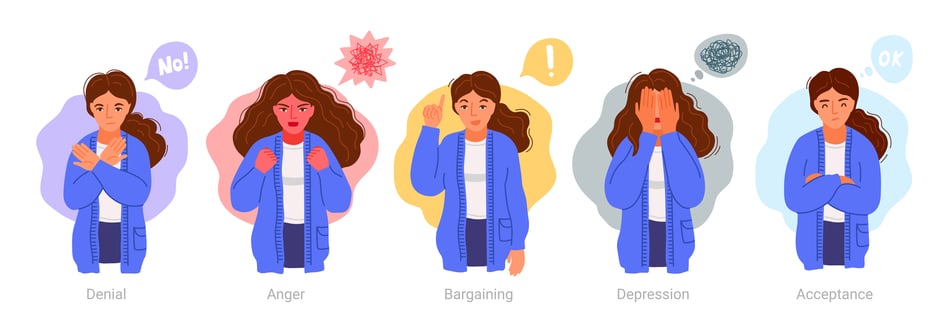 The 5 Stages of Grief
The 5 Stages of Grief
The 5 Stages of Grief
"Grief" is a tiny word that doesn’t just describe a feeling, but an entire process that is unique to each individual. Some people may feel angry or confused. Others, depressed. Still others may find they are numb and “feel nothing,” then wonder what is wrong with them.
There is no right or wrong way to grieve. Grief may cause a person to feel many emotions all at once. You might feel sad one day or angry the next. And while these emotions may feel “bad,” time is often the only way to get through the grief process.
Often, grief doesn’t only present itself through emotional responses, but also physical symptoms as well. Grief can cause some people to show negative effects on the body. Effects such as headaches, fatigue, nausea, lack of appetite, and even physical pain throughout the body.
One thing that can help with grief is to better understand it. Elisabeth Kubler-Ross is a Swiss psychiatrist who proposed a model for grief in her book, On Death and Dying. While her Five Stages of Grief is by no means the definitive approach to defining and understanding grief, it is an extremely useful framework to understanding the process of grieving.
Read and share the information below to learn more about the Five Stages of Grief.
What Are The 5 Stages of Grief

While each individual’s journey is different, many experience the same types of emotions, sometimes in a very linear way, sometimes all at once, and sometimes not at all.
The 5 Stages of Grief is one psychiatrist’s model of grief that might help you or a loved one understand grief better. Learn more below.
Stage 1. Denial
Many people experience Denial as the first stage in grieving. They might believe that a diagnosis is mistaken and instead hold to a different reality, refusing to even acknowledge what is actually happening.
They might even feel denial right after a death or feel "numb" or refuse to accept that their loved one is gone.
Stage 2. Anger
When an individual no longer can hold on to their denial, they will often feel angry or frustrated, and may take out their anger on those around them. They may also have conversations that surround questions or ideas of "This isn't fair!" "Why me?" or "Who is to blame?"
Stage 3. Bargaining
Bargaining is really about avoidance. An individual may try to avoid the cause of grief, like being around family or around the place of death. They may even try to change their own behavior: "If I get my life together, maybe this pain will go away."
Stage 4. Depression
This is the stage most people associate with grief. But it may be an emotion that’s not felt right away, or may be felt in spurts or in combination with anger or other stages. The individual may withdraw and refuse company, have trouble eating or overeat, or experience other symptoms of depression.
Stage 5. Acceptance
In this stage, the individual might not necessarily feel less sad, but they will say, "It's going to be okay. I can't fight this, but I can get through it." Calm may accompany this stage, as well as a more stable emotional state compared to the other stages in grieving.
While this model can be helpful for understanding your grief, it is important to remember that there is no right or wrong way to grieve. What is crucial is that each individual receives compassionate grief and loss support through a time of loss, whether it’s from friends or family, a spiritual leader, a support group or professional counseling.
Use the resources below to learn more about hospice or contact us anytime to ask questions about our services.
Support for the whole family
We believe in supporting the patient and their loved ones throughout the hospice experience.